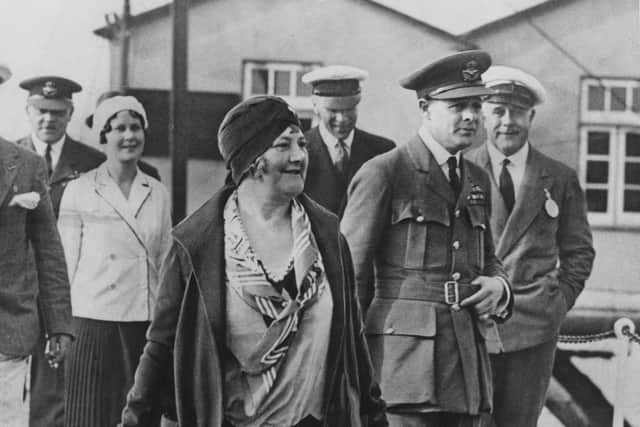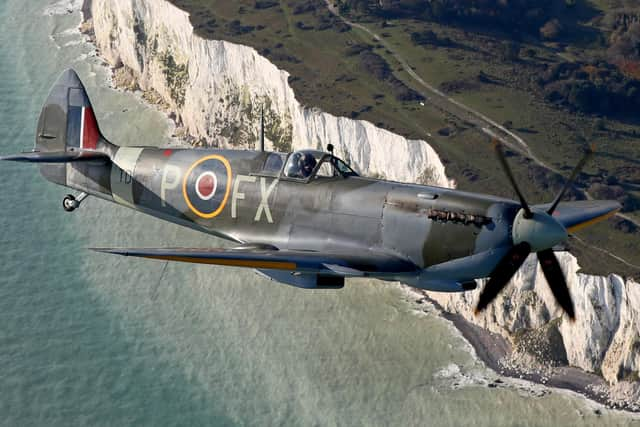Second World War: How former chorus girl who foresaw war in 1931 helped win the Battle of Britain – Susan Morrison
In October 1941, a brand new Spitfire named “Paisley” took to the skies. She was named in honour of the ‘Mill Girls’ of Paisley’s Ferguslie and Anchor Mills, who had raised the money to buy her for the war effort. Every plane counted, and this tremendous effort was highly appreciated. It wasn’t the first time women helped a Spitfire into the air.
In fact, without Lucy, Lady Houston, ‘Paisley’ and her sisters might never have taken to the skies at all. A complicated lady, our Lucy. She was born in South London, in 1857, the ninth of ten children. Her career choices were limited. Perhaps a place in domestic service, or a good marriage. Well, she would certainly go on to make marriage a career, but not before she hit the stage.
Advertisement
Hide AdAdvertisement
Hide AdBy 16, she was a chorus girl, and calling herself “Poppy”. It’s safe to say our girl was a stunner. It didn’t take long for her to catch some serious attention. Frederick “Freddy” Gretton was twice Lucy’s age when they met, but that gap seems no impediment to their blossoming relationship.
Freddy’s family co-owned the Bass Brewery. He was minted. They never married, but they were together for ten years, until the drink finally did for Freddy in 1882. He left Lucy £6,000 a year, a very comfortable sum, much to the disgust of his family.
Marriage to Lord Byron
Lucy was now very well off, but she may also have been lonely. It would explain why she eloped with Theodore Francis Brinckman, the son of a baronet. Sounds romantic, but it wasn’t. They separated shortly after that 1883 marriage and divorced in 1895.


It took another six years for Lucy to do the wedding march. This time it was with Lord Byron. No, not the “mad, bad and dangerous to know" one. This was the 9th Baron Byron, a quieter and poorer creature. He had lost his money to a swindling woman. Lucy paid his debts, and became Lady Byron.
During the Byron marriage, Lucy became an ardent, if slightly eccentric suffragette. She bought 600 parrots and tried to teach them to shout “Votes for Women”. It didn’t work. She was more successful during the First World War, when she set up rest homes for nurses coming back from the front, and distributed matches and socks to men serving in the trenches.
The 9th Baron died in 1917. After the war, Lucy had her money, her title and her award as a Dame Commander of the Order of the British Empire for her war work, and she also had an invitation from a dear friend. Sir Thomas Lipton had asked Lucy to join him on his yacht, and this was where she met her third husband, Sir Robert Houston.


Versailles Treaty a mistake
He wasn’t considered a great catch, despite his incredible wealth. The son of a Renfrewshire maritime engineer, he was known as “a hard, ruthless, unpleasant bachelor”. Lady Lucy Byron saw something in him, though, because she flirted with that man until she finally became Lucy, Lady Houston, in 1924. They were only married for two years. Sir Robert died aboard his luxurious Leith-built yacht ‘Liberty’, which he left to Lucy in his will. And £5.5 million.
Lucy, Lady Houston, was now one of the wealthiest women in Britain, and could have settled back to a life of ease in her houses, her Scottish shooting lodge or on her yacht, but she didn’t. It was 1931, and Lucy could see a war looming. She believed the Treaty of Versailles was a terrible mistake. Conflict was inevitable. She also believed that the next battles would be in the air.
Advertisement
Hide AdAdvertisement
Hide AdShe wasn’t alone. The Schneider trophy was an international airspeed race. Like Formula One race cars today, aircraft were built specifically to compete. On the surface, it was all healthy competition and racing camaraderie, but all the nations competing knew that the developments made by those aero designers and engineers fed directly into the design of the warplanes being built by Italy, France and Britain.
Not a straightforward hero
The 1931 race was critical. If Britain won, the prestigious trophy stayed in the UK. But Ramsay MacDonald’s government faced biting austerity and crippling debt. They simply could not justify the steep price tag for the competition. Supermarine, the company which had built previous trophy winners, was told to mothball the project. Not even the pleading of their brilliant designer, RJ Mitchell, could save the day. RAF pilots were directly ordered not to participate in the high-speed race.
Lucy stepped up and donated over £100,000 to make the Schneider Air Race happen, and to ensure the development of the Supermarine seaplane that lifted the trophy for Britain. Mitchell, using all the research and design from this seaplane, went on to build the most iconic fighter plane of the Second World War, the Spitfire.
It would have been a good nickname for Lucy. She wasn’t exactly the retiring sort, and she's not a straightforward hero for anyone’s cause. Ramsay MacDonald regularly got it in the neck for being a pacifist and, particularly, a socialist. She bought the Saturday Review newspaper mainly to blast away at anyone vaguely left of centre. She was an admirer of Mussolini and Hitler and saw more to fear from the Soviet Union than the fascists. She arranged for the first flight over Everest, but that was to protest plans for Indian independence.
But still, without her money, the Battle of Britain might have gone in a different way. Lucy never got to see the Spitfire. She died in 1936, at her home in Byron Cottage. On December 8, 1941, Spitfire “Paisley'' was shot down off the coast of France. Her pilot, Canadian Pilot Officer John Ronald Coleman was killed. He was 21.
Comments
Want to join the conversation? Please or to comment on this article.

